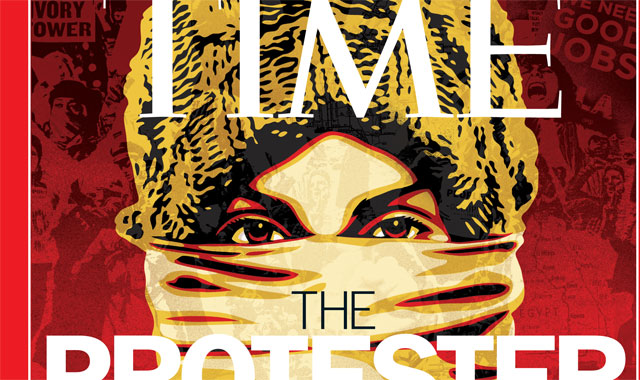TIME, they are a changing. After Newt Gingrich in 1995, GW Bush in 2000, and Bennie Bernanke in 2009, the TIME person of the year 2011 is… The Protester. As Kurt Andersen writes in his accompanying analysis:
Once upon a time, when major news events were chronicled strictly by professionals and printed on paper or transmitted through the air by the few for the masses, protesters were prime makers of history. Back then, when citizen multitudes took to the streets without weapons to declare themselves opposed, it was the very definition of news — vivid, important, often consequential. In the 1960s in America they marched for civil rights and against the Vietnam War; in the ’70s, they rose up in Iran and Portugal; in the ’80s, they spoke out against nuclear weapons in the U.S. and Europe, against Israeli occupation of the West Bank and Gaza, against communist tyranny in Tiananmen Square and Eastern Europe. Protest was the natural continuation of politics by other means.
And then came the End of History, summed up by Francis Fukuyama’s influential 1989 essay declaring that mankind had arrived at the “end point of … ideological evolution” in globally triumphant “Western liberalism.” The two decades beginning in 1991 witnessed the greatest rise in living standards that the world has ever known. Credit was easy, complacency and apathy were rife, and street protests looked like pointless emotional sideshows — obsolete, quaint, the equivalent of cavalry to mid-20th-century war. The rare large demonstrations in the rich world seemed ineffectual and irrelevant.
There were a few exceptions, like the protests that, along with sanctions, helped end apartheid in South Africa in 1994. But for young people, radical critiques and protests against the system were mostly confined to pop-culture fantasy: “Fight the Power” was a song on a platinum-selling album, Rage Against the Machine was a platinum-selling band, and the beloved brave rebels fighting the all-encompassing global oppressors were just a bunch of characters in The Matrix.
Massive and effective street protest” was a global oxymoron until — suddenly, shockingly — starting exactly a year ago, it became the defining trope of our times. And the protester once again became a maker of history.”
Today’s protester, however, is not the protester of the 1960s. As Robin van den Akker noted in an earlier article,
#occupy must be seen as an open source-movement – a wikiprotest. This explains why many a babyboomer of the ludic 1960s or the political 1970s and many a member of the lost generation of the cynical 1980s or the ironic 1990s struggles to understand its methods, organisation and aims. Whereas the network generation attempts to create, after Wikipedia, a movement that anyone can edit, a movement that is self-organised, inclusive and open-ended, they merely see a protest without strong leaders, clear demands and ultimatums.
But if the protester 2.0 is the person of 2011, who will next year’s person of the year be? The utopian ‘You’ from 2006 was followed by Vladimir Putin, 2008s Obama by Bernanke. Will it be the mac using dissident? The cautious interrupter? The uncertain believer? The populist?


On a personal note, I think I would have chosen Mohamed Bouazizi as person of the year, seeing as his lone action triggered the unrest in Tunesia that spread across the other Arab countries.
Of course, there is no real link with the protesters at Occupy Wallstraat, as those follow a completely different process.